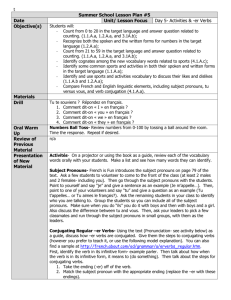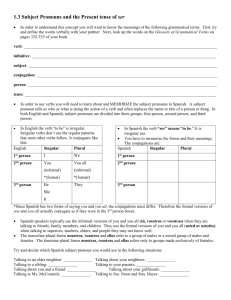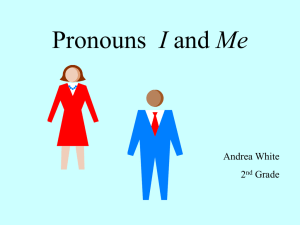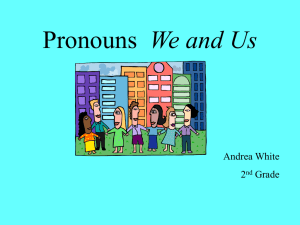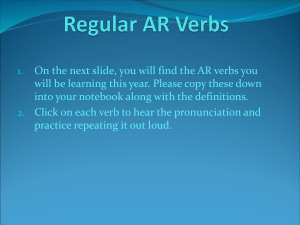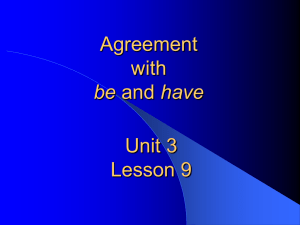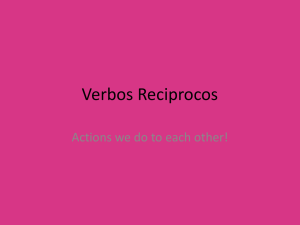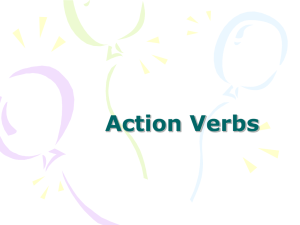Round LAP - WordPress @ Clark U
advertisement
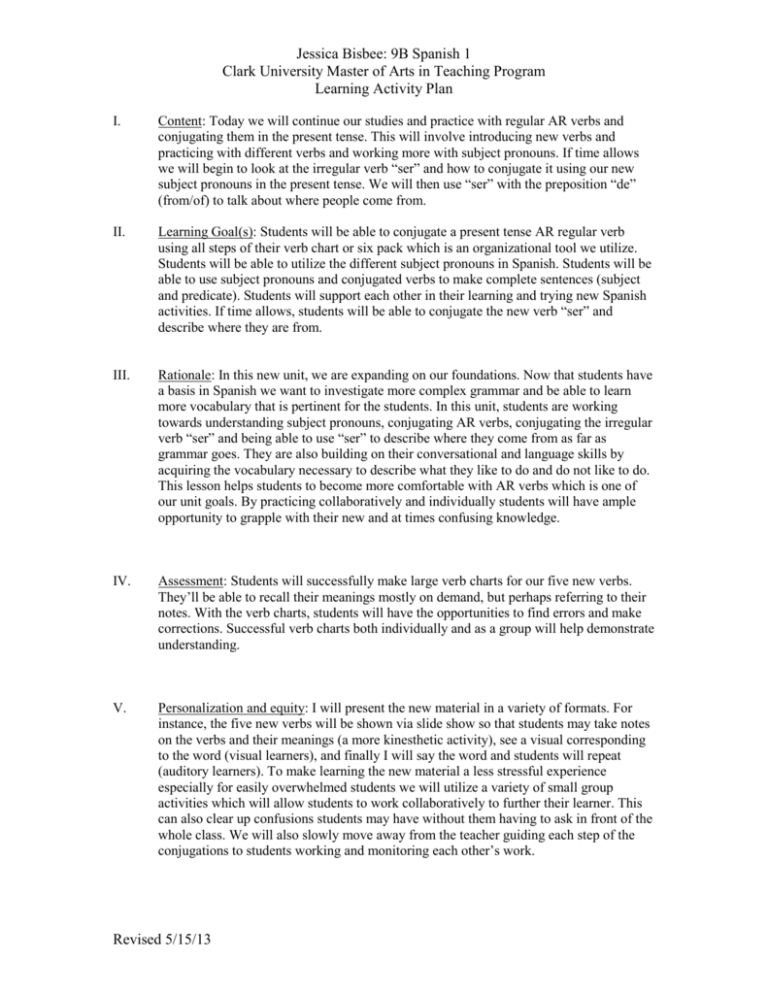
Jessica Bisbee: 9B Spanish 1 Clark University Master of Arts in Teaching Program Learning Activity Plan I. Content: Today we will continue our studies and practice with regular AR verbs and conjugating them in the present tense. This will involve introducing new verbs and practicing with different verbs and working more with subject pronouns. If time allows we will begin to look at the irregular verb “ser” and how to conjugate it using our new subject pronouns in the present tense. We will then use “ser” with the preposition “de” (from/of) to talk about where people come from. II. Learning Goal(s): Students will be able to conjugate a present tense AR regular verb using all steps of their verb chart or six pack which is an organizational tool we utilize. Students will be able to utilize the different subject pronouns in Spanish. Students will be able to use subject pronouns and conjugated verbs to make complete sentences (subject and predicate). Students will support each other in their learning and trying new Spanish activities. If time allows, students will be able to conjugate the new verb “ser” and describe where they are from. III. Rationale: In this new unit, we are expanding on our foundations. Now that students have a basis in Spanish we want to investigate more complex grammar and be able to learn more vocabulary that is pertinent for the students. In this unit, students are working towards understanding subject pronouns, conjugating AR verbs, conjugating the irregular verb “ser” and being able to use “ser” to describe where they come from as far as grammar goes. They are also building on their conversational and language skills by acquiring the vocabulary necessary to describe what they like to do and do not like to do. This lesson helps students to become more comfortable with AR verbs which is one of our unit goals. By practicing collaboratively and individually students will have ample opportunity to grapple with their new and at times confusing knowledge. IV. Assessment: Students will successfully make large verb charts for our five new verbs. They’ll be able to recall their meanings mostly on demand, but perhaps referring to their notes. With the verb charts, students will have the opportunities to find errors and make corrections. Successful verb charts both individually and as a group will help demonstrate understanding. V. Personalization and equity: I will present the new material in a variety of formats. For instance, the five new verbs will be shown via slide show so that students may take notes on the verbs and their meanings (a more kinesthetic activity), see a visual corresponding to the word (visual learners), and finally I will say the word and students will repeat (auditory learners). To make learning the new material a less stressful experience especially for easily overwhelmed students we will utilize a variety of small group activities which will allow students to work collaboratively to further their learner. This can also clear up confusions students may have without them having to ask in front of the whole class. We will also slowly move away from the teacher guiding each step of the conjugations to students working and monitoring each other’s work. Revised 5/15/13 Jessica Bisbee: 9B Spanish 1 Clark University Master of Arts in Teaching Program Learning Activity Plan VI. Activity description and agenda Activity Starter: Open response on a separate sheet of paper to be collected. Total Physical Response: Subject pronouns Activity 6 page 38 in textbooks & Review Group Conjugation 5 new AR verbs (introduction & slides) In small groups/ repetition of vocabulary Conjugation practice Conjugations Charts Revised 5/15/13 Description “What are subject pronouns? Why do we need subject pronouns? Why do we need verbs? How did we begin to use both these elements in yesterday’s class?” Extension: Describe conjugating. What does it mean to conjugate a verb? Have students indicate using their arms to motion towards others the meanings of the subject pronouns we learned yesterday. (Example: If the teacher says “yo” motion towards yourself) Write the pronoun that corresponds to the image. (six images) review answers as a group. Finish conjugating the verb “llamar” as an example (we need to add the endings). Then walk through “dibujar” together. Show images with new verbs. Say them once aloud, count to three, and students repeat as a whole quickly. Students in groups of 4-5 will practice the new verbs. One student begins by saying the English. The next says the Spanish equivalent. The students keep alternating until they go around the circle twice for each verb. Individually fill out the conjugations for each verb on our handout following all steps on our conjugation check list. In groups of four, students go to a poster with a verb chart on the wall (one for Time 5 min 5 min 7 min 10 min 3 min 5 min 7 min 5 min Jessica Bisbee: 9B Spanish 1 Clark University Master of Arts in Teaching Program Learning Activity Plan Group Review Wrap Up each new verb). They need to use a marker to fill in one slot of the verb chart. Then they will be asked to move to the next chart and do the same. This repeats until they land on a fully filled out chart. At this chart they need to make any corrections. With students back in their seats, turn and look at each chart. Go through the conjugations (they can correct their own sheets/fill them in). Do we agree with the conjugations? (Thumbs up) Do we disagree with something on the chart? (Thumbs down) Briefly review what we looked at today & hand out homework exercise sheet. 5 min Remainder of class. a. I anticipate that students will still be struggling with conjugating verbs because it is unlike anything we have seen or done consciously even for native speakers. Therefore, I will use groups so students can support and help each other learn and make corrections. I also anticipate that each of my students learn differently so I am using a variety of tools to convey and practice this new vocabulary (listening, speaking, seeing, and writing). VII. List the Massachusetts Learning Standards this lesson addresses. a. Linguistic Comparisons b. Presentational Communication VIII. Reflection Please see reflections document. Revised 5/15/13


